
![]()
Search the Journey to Forever website – click HERE
|
Journey to Forever: Make a donation |
Navigation
| Small farms library | |
| City farms | |
| Organic gardening | |
| Composting | |
| Small farms | |
| Introduction Sustainable farming Small farms fit References |
|
| Small farm resources | |
| Back to the land | |
| Small farms | |
| Organics | |
| Soil management | |
| Sustainable farming | |
| General resources | |
| Food storage and preservation | |
| Useful databases | |
| Community-supported farms | |
| Farming with trees | |
| Agroforestry Bamboo Resources |
|
| Farming with animals | |
| Introduction Livestock resources Cattle Sheep General Draft animals |
|
| Pasture | |
| Introduction Pasture resources Silage |
|
| Pigs for small farms | |
| Why pigs have snouts Raising pigs on soil in Japan Lady Eve's pigs Pigs on pasture Pig resources |
|
| Poultry for small farms | |
| Muscovy ducks Khaki Campbell ducks Chickens Geese Rabbits Guineafowl General tips High-protein poultry feed from thin air Poultry as unpaid labour They're not pets Doing it |
|
| Poultry resources | |
| Aquaculture for small farms | |
| Introduction Aquaculture resources |
|
| Composting for small farms | |
| Foundation On-farm composting resources |
|
| Controlling weeds and pests | |
| Weeds Weed control resources Insect pests No pesticides Insect control resources |
|
Contact usTo Keith Addison Handmade Projects |
Pasture for small farmers
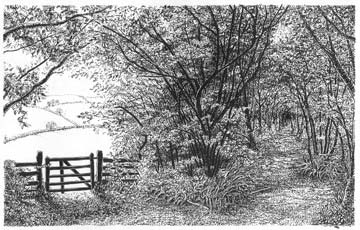
Forest and meadows (Christine Thery)
A rye plant may have as much as 25 miles of roots. A rye grass plant may have as much as 350 miles of roots. This is the difference between grassland and other land: grassland topsoil is a dense web of roots.
Grassland is not just grass: there will also be legumes (such as clovers) and deep-rooting herbs ("weeds", also known as forbs). The legumes have nodules in their roots colonized by special soil bacteria (rhizobia) that "fix" nitrogen from the atmosphere into food for plants. The herbs bring up new minerals from the subsoil and replenish the topsoil.
The most important aspect of grassland is the grazing animals that eat the grass. Along with the grazing itself and their trampling effect, it is the action of the animals' dung and urine in fertilizing the topsoil that makes such lush growth and crop density possible.
Pasture and grazers can almost be viewed as a composite creature, the one an aspect of the other. In a sense the grazers cause the pasture: remove the animals and the land changes.
First the annual "weeds" take over, followed by briars and shrubs, then young trees. After a few years there are mainly trees, and eventually a closed-canopy forest. This is called a natural succession.
Not understanding the process of natural succession is why people try to fight weeds instead of manipulating soil, crops, trees and livestock in genetically diverse patterns which accomplish what the weeds are trying to accomplish.
You see grassland but no grazing animals? Look closer: one of the main grazing animals of Europe and North America, if not the main one, is not cattle or sheep, but the tiny vole (field mouse), with its myriad runs under the surface of the grass. Voles and rabbits can maintain grassland all by themselves. And both wreck trees.
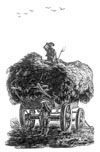
On a farm, pasture has two main functions: it's immensely productive, and it can be used to provide enough fertility for a following succession of crops. This is ley farming, the foundation of mixed-farming rotations, a productive and sustainable system.
Pastures can be grazed or mown for hay, storing the grass for later feeding. See Haying FAQ, below. If you can find someone who knows how, learn how to dry hay on tripods, and you'll have the best hay going, the animals choose it every time. Silage is another method of conserving hay, through fermentation, a bit like making sauerkraut.
See also:
Poultry for small farms
Pigs for small farms, Pigs on pasture
Farming with animals
Pasture resources
Ley Farming by Sir R. George Stapledon and William Davies, 1948, Faber & Faber, London. Sow a piece of land with a good pasture mixture and then divide it in two with a fence. Graze one half heavily and repeatedly with cattle, mow the other half as necessary and leave the mowings there in place to decay back into the soil. On the grazed half, you've removed the crop (several times) and taken away a large yield of milk and beef. On the other half you've removed nothing. Plough up both halves and plant a grain crop, or any crop. Which half has the bigger and better yield? The grazed half, by far. "Ley Farming" explains why "grass is the most important crop" and how to manage grass leys. Leys are temporary pastures in a rotation, and provide more than enough fertility for the succeeding crops: working together, grass and grazing animals turn the land into a huge living compost pile. Stapledon draws on the work of Robert H. Elliot of Clifton Park, whose work with deep-rooting leys was the culmination of hundreds of years of development in grass rotation farming. Full-text online at the Small Farms Library.
The Clifton Park System of Farming, and laying down land to grass -- a guide to landlords, tenants and land legislators by Robert H. Elliot, introduction by Sir R. George Stapledon, 1898, 1943, Faber and Faber. The master-work of the ley farming rotational grazing system of laying down cropland to grass -- actually a complex mixture of grasses, legumes and deep-rooting herbs (aka weeds). The grass ley provided beef and dairy produce, as well as enough high-grade soil fertility for a succession of grain and root crops after the grass was ploughed up -- truly sustainable farming. Full-text online at the Small Farms Library.
See section on Ley farming in the Small Farms Library.
Good set of four FAQs from 18 James, home site for rural FAQs for small producers, useful information. Detailed advice -- the Pasture FAQ is more than 16,000 words, well-written and knowledgeable.
Pasture FAQ, establishing, maintaining, and utilizing livestock pastures;
Haying FAQ, growing, harvesting, and storing hay;
Lambing FAQ, lambing, and the care of ewes and lambs;
Predator FAQ, identifying and thwarting livestock predators.
http://www.18james.com
"The Economy of Low-Cost Homestead Haymaking: The Whole Story" by Spyridon (Rick) Grossman. There is no reason that anyone with access to a meadow or unused pasture cannot make their own hay. The tools are very simple. Something to mow with, a rake, a fork to handle the hay, a wagon to haul it, and a place to store it. Weather is more important than the type of tools. Here's how.
http://www.hooiberg.info/divers/denkna.htm
"Salad Bar Beef" by Joel Salatin, 1995
"Salad bar beef receives no grain -- ever. God made multi-stomached animals to eat forages." Quite right too. Salatin's salad bar beef program is a proven, profitable prototype for small herds, yielding a high-quality, competitively priced, high profit-margin product. No more feed lots! This how-to book explains the why, how, and who of small-scale, organic livestock management. From Chelsea Green:
http://www.chelseagreen.com/2004/items/516
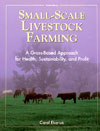 "Small-Scale Livestock Farming: A Grass-Based Approach for Health, Sustainability, and Profit" by Carol Ekarius, 1999, Storey Books, ISBN 1580171621
"Small-Scale Livestock Farming: A Grass-Based Approach for Health, Sustainability, and Profit" by Carol Ekarius, 1999, Storey Books, ISBN 1580171621
Natural, organic approach to livestock management that produces healthier animals, reduces feed and health-care costs, and increases profits. Basics of animal housing, fencing, health, reproduction, and feeding. In four sections: overview, animal husbandry, marketing (conventional and alternative), planning. With interviews and information from other farmers and ranchers all over the US. From Powell's Books:
http://www.powells.com/biblio/17-9781580171625-0
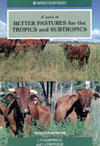 "A Guide to Better Pastures for the Tropics and Subtropics" by L.R. Humphreys and I.J. Partridge, NSW Agriculture, revised 5th edition 1995, ISBN 1 86277
"A Guide to Better Pastures for the Tropics and Subtropics" by L.R. Humphreys and I.J. Partridge, NSW Agriculture, revised 5th edition 1995, ISBN 1 86277
Good resource for tropical pasture development. Why sow pastures? -- establishing pastures -- fertilizing pastures -- managing pastures -- selecting pasture mixtures -- pasture grasses -- pasture legumes -- pasture species for irrigation or high altitude country -- fodder crops -- sowing guide. Four chapters online: Grasses for the tropics, Legumes for the tropics, Grasses for the subtropics, Legumes for the subtropics -- with fact-sheets for each species.
http://www.dpi.qld.gov.au/pastures/4605.html
Order the complete book from the CB Alexander Agricultural College, NSW Agriculture:
http://www.agric.nsw.gov.au/Agedu/Tocal/wstrop.htm
Useful list of books on tropical pastures at the Tropical Grassland Society of Australia, order form online:
http://www.tropicalgrasslands.asn.au/
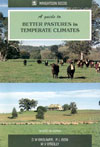 "A Guide to Better Pastures in Temperate Climates", by D.W. Brouwer, R.L. Ison, M.V. O'Reilly, NSW Agriculture, 1994, ISBN 0 9594313 3 0
"A Guide to Better Pastures in Temperate Climates", by D.W. Brouwer, R.L. Ison, M.V. O'Reilly, NSW Agriculture, 1994, ISBN 0 9594313 3 0
Pasture improvement, the place of legumes in soil, pasture and crop improvement, fertilizers, pasture establishment and maintenance, selecting species, cultivars and mixtures, pasture grasses, pasture legumes, pasture management, fodder conservation and fodder crops, seed quality, reference charts and sowing guide. From the CB Alexander Agricultural College, NSW Agriculture:
http://www.agric.nsw.gov.au/Agedu/Tocal/wstemp.htm
The Forage Information System is a big site with extensive resources on virtually all aspects of the subject. The Animals page, for instance, has information on Breeds, Farms/Ranches, General Info, Markets, Nutrition, Prices, Organizations, and Publications/Other Media for Beef, Bison, Buffalo, Dairy, Deer/Elk, Goat, Horse, Llama, Mule, Poultry, Rhatite, Sheep, Swine, and General Information. Also Cover Crops, Economics, Hay, Pasture, Pests, Quality & Testing, Silage, Species, Statistics. Separate Resources section offers links for Forage Information Systems, International links, Media, People, Publications, and Vendors. Publications can be sorted and browsed by Type (Books, Journals, Newsletters...) or by Subject Matter (Silage, Pasture, Hay...), or search the Publications database.
http://forages.orst.edu/
Pasture Management at The Small Farm Resource. Useful FAQ on managing pasture, lots more resources here on grass types, erosion control, manure management, silage, weeds, fences, sheep, goats, even ostriches. Try the site search engine.
http://www.farminfo.org/property/pastmgmt-m.htm
Forage for cattle:
http://www.farminfo.org/dairy/forage-m.htm
Forage Crops:
http://www.farminfo.org/forage/default.htm
"The Stockman Grass Farmer -- The Grazier's Edge" -- A publication devoted entirely to the art and science of turning grass into beef, lamb or milk -- ie, cash flow. Serves as an information network for grassland farmers sharing the latest in intensive grazing technology and pasture management. Subscriptions, bookshelf, audio tapes.
http://www.stockmangrassfarmer.com/
"Why Grassfed is Best!", a new book by New York Times bestselling author Jo Robinson, explores the many benefits of grassfed meat, eggs, and dairy products. This is the website for the book, with much of interest on the nutritional benefits of grass, environmental benefits, new research.
http://eatwild.com/index.html
A Campaign for Real Milk -- "What’s needed today is a return to humane, non-toxic, pasture-based dairying and small-scale traditional processing." Also in French and German.
http://www.realmilk.com/why.html
A project of theWeston A. Price Foundation:
http://www.WestonAPrice.org
Back40Books -- Free-range poultry is a sustainable and profitable system. It was the norm in the US until it was superceded by industrial agriculture and confinement systems in the 1960s. Herman Beck-Chenoweth has updated and modernized the old techniques in his "Modern American Free-Range System" -- this really is free range, not just a mobile confinement system with grass underneath. Resources and links, along with the Back40Books online book catalog, featuring books on poultry, other livestock, farming, country skills, and much besides.
http://www.free-rangepoultry.com/
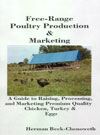 "Free-Range Poultry Production and Marketing Range Poultry Production: A Complete Guide to Raising, Processing and Marketing Free-Range Chicken, Turkey and Eggs" by Herman Beck-Chenoweth.
"Free-Range Poultry Production and Marketing Range Poultry Production: A Complete Guide to Raising, Processing and Marketing Free-Range Chicken, Turkey and Eggs" by Herman Beck-Chenoweth.
The free-range system can produce healthier birds in larger quantities, more humanely, with much less labor. Complete with feed formulas, equipment plans, slaughter tips and marketing suggestions this is the one book you need to raise up to 20,000 birds per year with much less work than you thought was possible. Meat and egg chickens and turkeys. The book was produced with the assistance of the USDA Department of Sustainable Agriculture and Development (SARE). Companion video also available. From Back40Books:
http://www.back40books.com/store/prodinfo.asp?
number=0-918779-00-6&variation=&aitem=4&mitem=17
"Range Poultry Forum Magazine: The Journal of Producing, Processing and Marketing Premium Quality Chicken, Turkey and Eggs" -- valuable information for ANY grass-based poultry producer regardless of system. Regular features on producers, hatchery profiles, direct marketing, predators, processing and more. Irregularly published; subscription is for four issues. Back issues available.
https://raju.safe-order.net/free-rangepoultry/p53.html
"Forages", by Dr. Franklin W. Martin, 1993, ECHO Technical Note. Forages on the small farm -- tropical focus. Management, recommended forages, grasses, legumes, other forage plants, tables and plant descriptions, seed and other resources.
http://www.echotech.org/mambo/images/DocMan/Forages.PDF
"Better Pastures for the Tropics", Yates, 1975 (Yates Agricultural Seeds, P.O. Box 117, Rockhampton, Queensland, 4700, Australia -- useful booklet on the seed company's work developing tropical pastures.
Silage
Silage at Indore, India: "A special feature of the food supply of the oxen was the provision of ample silage for the months March to June, when little or no grazing was available on account of the dry, hot weather. The silage was made from the locally grown tall millet, cut up by means of a portable chaff cutter driven by a 5 h.p. portable oil engine. The cut silage was filled into pits about four feet deep with sloping sides and an earthen bottom for drainage. To prevent the infiltration of air into the mass from the surrounding earth the sides were leeped with a thick, moist, clay slurry just before filling. The cut silage was moistened by means of a sprinkler as it went into the pits, each of which was so designed that it could be filled with moist silage and covered in during one day's work. This is essential for the best results. It never pays to fill a silo bit by bit, as is so often the case in Great Britain. The centre of each filled silage pit was about eighteen inches above the ground level, the edges were flush with the undisturbed soil, a thin covering of dried grass was then applied, followed by a foot of earth. On the top of this earth covering were laid some heavy blocks of stone. All this consolidated the moist silage and allowed the proper fermentation to begin. No additions such as molasses were ever used. Proceeding in this manner, excellent silage was obtained with practically no loss. Indeed, damage by percolating air was impossible, while the small amount of liquid produced was absorbed by the earth below." -- Sir Albert Howard, "Farming and Gardening for Health or Disease (The Soil and Health)", Chapter 9, Disease and Health in Livestock (Faber & Faber, London, 1945, Devin-Adair 1947, Schocken 1972). Full text online at the Small Farms Library.
"Barn Plans & Outbuildings", Byron D. Halsted, Orange Judd Co, 1881, 1889 edition reprint 1999, Algrove Publishing, ISBN 0-921335-64-4
This great book on 19th-century American farm buildings includes a very good 10-page section on making silage: The Preservation of Fodder in Silos, with lots of detail and good engravings and diagrams. From Powell's Books:
http://www.powells.com/biblio/4-9780921335641-0
Small farms
Small farm resources
Community-supported farms
Farming with trees
Farming with animals
Pasture
Pigs for small farms
Poultry for small farms
Aquaculture for small farms
Composting for small farms
Controlling weeds and pests
Small farms library
City farms
Organic gardening
Building a square foot garden
Plant spacing guides
No ground? Use containers
When to sow what
Seeds
Garden pond
Gardening resources
Composting
Making compost
Composting resources
Composting indoors
Vermicomposting
Humanure
Composting for small farms